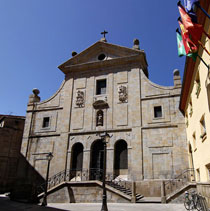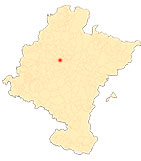pathway Teresian in Pamplona
Introduction
civil service examination In the context of the establishment of the sons of Saint Ignatius in Pamplona by the clergy, a letter from Saint Teresa dated 8 May 1580 in Toledo is contextualised, in which she joins the bishop and the viceroy in their support for the presence of the Jesuits in the city. This would be the first active influence of the saint from Avila in the capital of Navarre. Shortly afterwards, Saint Teresa herself and Father Gracián were again involved in the preparations for the foundation of the convent of San José de las Madres de Pamplona, with Leonor de la Misericordia (Ayanz y Beaumont) and Beatriz de Beaumont and Don Martín Cruzat taking an active part in its realisation. During the presence of the Fathers in Pamplona, their establishment was promoted by the prioress of the same city, Mother Catalina de Cristo and the Navarrese nobleman Martín Cruzat y Oiz. The convent of the Descalzos has been preserved intact to the present day, but not the convent that the nuns lived in at place del Castillo.
Pamplona collaborated through its Regiment in the celebrations for the beatification and canonisation of Saint Teresa in 1614 and 1622, respectively. The city preserves important representations of her, which depict different scenes from her life, especially her visions and ecstasies, so in tune with the 17th century, which was captivated by the marvellous and theatrical nature and the sensitive forms with which the imagination translated ineffable grandeurs. The sources of inspiration for the artists were the Book of her life, the early biographies and, above all, the engravings of her illustrated life, commissioned by Mother Anne of Jesus in Antwerp in 1613 from Cornelius Galle and Adrian Collaert in 1613, one copy of which is kept by the Descalzas de San José in Pamplona.
-
FERNÁNDEZ GRACIA, R., "El convento e iglesia de los Carmelitas Descalzos de Pamplona. Architecture", Príncipe de Viana, 164, 1981, pp. 787-818.
-
ECHEVERRÍA GOÑI, P. and FERNÁNDEZ GRACIA, R., "El convento e iglesia de los carmelitas descalzos de Pamplona. Exorno artístico", Príncipe de Viana, 164, 1981, pp. 819-891.
-
AZANZA LÓPEZ, J. J., Arquitectura Religiosa Barroca en Navarra, Pamplona, Government of Navarre, 1996.
-
FERNÁNDEZ GRACIA, R., El retablo barroco en Navarra, Pamplona, Government of Navarre, 2003.
-
FERNÁNDEZ GRACIA, R., The Immaculate Conception in Navarre. Art and devotion during the centuries of the Baroque Mentors, artists and iconography. Pamplona, Eunsa, 2004.
-
FERNÁNDEZ GRACIA, R., Engraving, Counter-Reformation and Teresian Carmel. The collection of engravings of the Discalced Carmelites of Pamplona and Leonor de la Misericordia (Ayanz and Beaumont). Pamplona, I. G. Castuera, 2004.
-
FERNÁNDEZ GRACIA, R., "Santa Teresa", Juan de Goyeneche y el triunfo de los navarros en la Monarquía Hispánica del siglo XVIII, Pamplona, Fundación Caja Navarra, 2005, p. 352.
-
FERNÁNDEZ GRACIA, R., "Algunas esculturas napolitanas en Navarra", Pulchrum. Scripta in honorem Mª Concepción García Gainza, Pamplona, Government of Navarre, department de Cultura y Turismo-Institución Príncipe de Viana, 2011, pp. 300-310.
-
TARIFA CASTILLA, M. J., "Aparición de Cristo a Santa Teresa", Pamplona y San Cernin 1611-2011. IV Centenary of the Vow of the City, Pamplona, Pamplona City Council, 2011, p. 176.












